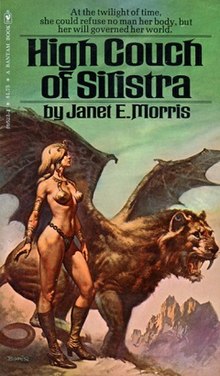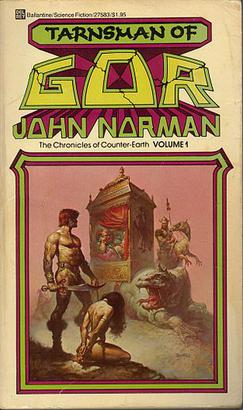
Gor is the fictional setting for a series of sword and planet novels written by philosophy professor John Lange, writing as John Norman. The setting was first described in the 1966 novel Tarnsman of Gor. The series is inspired by science fantasy pulp fiction works by Edgar Rice Burroughs, such as the Barsoom series. It also includes erotica and philosophical content. The Gor series repeatedly depicts men abducting and physically and sexually brutalizing women, who grow to enjoy their submissive state. According to The Encyclopedia of Science Fiction, Norman's "sexual philosophy" is "widely detested", but the books have inspired a Gorean subculture.

Sword and sorcery (S&S) or heroic fantasy is a subgenre of fantasy characterized by sword-wielding heroes engaged in exciting and violent adventures. Elements of romance, magic, and the supernatural are also often present. Unlike works of high fantasy, the tales, though dramatic, focus on personal battles rather than world-endangering matters. The genre originated from the early-1930s works of Robert E. Howard. The term "sword and sorcery" was coined by Fritz Leiber in the 6 April 1961 issue of the fantasy fanzine Ancalagon, to describe Howard and the stories that were influenced by his works. In parallel with "sword and sorcery", the term "heroic fantasy" is used, although it is a more loosely defined genre.
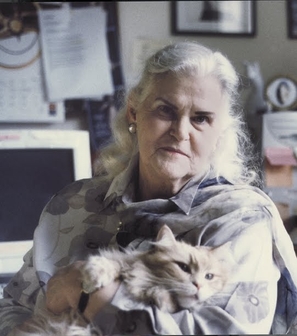
Anne Inez McCaffrey was an American writer known for the Dragonriders of Pern science fiction series. She was the first woman to win a Hugo Award for fiction and the first to win a Nebula Award. Her 1978 novel The White Dragon became one of the first science-fiction books to appear on the New York Times Best Seller list.

The Gunslinger is a dark-fantasy novel by American author Stephen King. It is the first volume in the Dark Tower series. The Gunslinger was first published in 1982 as a fix-up novel, joining five short stories that had been published between 1978 and 1981. King substantially revised the novel in 2003; this version has remained in print ever since, with the subtitle RESUMPTION. The story centers Roland Deschain, the last gunslinger, who has been chasing his adversary, "the man in black," for many years. The novel fuses Western fiction with fantasy, science fiction, and horror, following Roland's trek through a vast desert and beyond in search of the man in black. Roland meets several people along his journey, including a boy named Jake, who travels with him part of the way.

Philip José Farmer was an American author known for his science fiction and fantasy novels and short stories.

Stephen Reeder Donaldson is an American fantasy, science fiction and mystery novelist, most famous for The Chronicles of Thomas Covenant, his ten-novel fantasy series. His work is characterized by psychological complexity, conceptual abstractness, moral bleakness, and the use of an arcane vocabulary, and has attracted critical praise for its "imagination, vivid characterizations, and fast pace". Donaldson earned his bachelor's degree from The College of Wooster and a Master's degree from Kent State University. He currently resides in Albuquerque, New Mexico.

The Colour of Magic is a 1983 fantasy comedy novel by Terry Pratchett, and is the first book of the Discworld series. The first printing of the British edition consisted of only 506 copies. Pratchett has described it as "an attempt to do for the classical fantasy universe what Blazing Saddles did for Westerns."
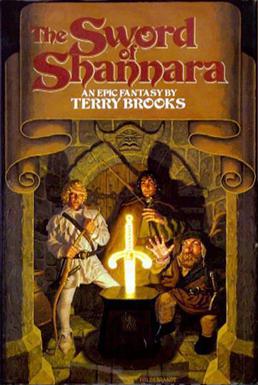
The Sword of Shannara is a 1977 epic fantasy novel by American writer Terry Brooks. It is the first book in a titular trilogy.

Fantasy literature is literature set in an imaginary universe, often but not always without any locations, events, or people from the real world. Magic, the supernatural and magical creatures are common in many of these imaginary worlds. Fantasy literature may be directed at both children and adults.

Planetary romance is a subgenre of science fiction or science fantasy in which the bulk of the action consists of adventures on one or more exotic alien planets, characterized by distinctive physical and cultural backgrounds. Some planetary romances take place against the background of a future culture where travel between worlds by spaceship is commonplace; others, particularly the earliest examples of the genre, do not, and invoke flying carpets, astral projection, or other methods of getting between planets. In either case, it is the planetside adventures which are the focus of the story, not the mode of travel.

Elements of the supernatural and the fantastic were an element of literature from its beginning. The modern genre is distinguished from tales and folklore which contain fantastic elements, first by the acknowledged fictitious nature of the work, and second by the naming of an author. Works in which the marvels were not necessarily believed, or only half-believed, such as the European romances of chivalry and the tales of the Arabian Nights, slowly evolved into works with such traits. Authors like George MacDonald (1824–1905) created the first explicitly fantastic works.
Mark Morris is an English author known for his series of horror novels, although he has also written several novels based on the BBC Television series Doctor Who. He used the pseudonym J. M. Morris for his 2001 novel Fiddleback.
Janet Ellen Morris is an American author of fiction and nonfiction, best known for her fantasy and science fiction and her authorship of a non-lethal weapons concept for the U.S. military.
Lafayette Ronald Hubbard, better known as L. Ron Hubbard, was an American pulp fiction author. He wrote in a wide variety of genres, including science fiction, fantasy, adventure fiction, aviation, travel, mystery, western, and romance. His United States publisher and distributor is Galaxy Press. He is perhaps best known for his self-help book, the #1 New York Times bestseller Dianetics: The Modern Science of Mental Health, and as the founder of the Church of Scientology.
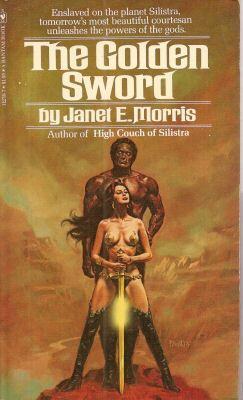
The Golden Sword, published in 1977, is a science fantasy novel by American writer Janet Morris, the second title in her High Couch of Silistra series.

Wind from The Abyss is a science fantasy novel by American writer Janet Morris, published in 1978. It is the third book of her Silistra series.

The following outline is provided as an overview of and topical guide to fantasy:
